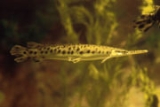
Holostei
Encyclopedia
Holostei are bony fish that show primitive characteristics. There are eight species divided among two orders, the Amiiformes
represented by a single living species, the bowfin (Amia calva), and the Lepisosteiformes, the gars. There are more species to be found in the fossil record.
Holostei share with other primitive fishes a mixture of characteristics of teleosts
and shark
s. In comparison with the other group of primitive fishes, the chondrosteans
, the Holostei are closer to the teleosts and further from sharks: the pair of spiracle
found in sharks and chondrosteans is reduced to a remnant structure (in gars, the spiracles does not open to the outside);
the skeleton is ossified
(a thin layer of bone covers a mostly cartilaginous
skeleton in the bowfins). In gars, the tail is still heterocercal but less so than in the chondrosteans; bowfins have many rayed dorsal fins and can breathe air like the bichir
s.
The gars have thick ganoid scales typical of sturgeon
s whereas the bowfin has thin bony scales like the teleosts. The gars are therefore in this regard considered more primitive than the bowfin.
The Holostei is often regared as paraphyletic
; as a result this infraclass is often not used, the two orders contained in it being often treated simply as members of the sub-class Neopterygii
without any taxonomic association. However, recent work mitochondrial analysis of DNA seems to support its recognition, so the question is not yet resolved. Nearly all living bony fishes are teleosts.
The name derives from the Greek
, holos meaning whole and osso (osteo) meaning bone: a reference to their bony skeletons.
Amiiformes
Amiiformes is an order of fish, of which only one species, the Bowfin, Amia calva, is still extant.-Taxonomy:Amiiformes Hay 1929*Superfamily Amioidea Bonaparte 1838**Family Amiidae Bonaparte 1837***Subfamily Amiinae Bonaparte 1837...
represented by a single living species, the bowfin (Amia calva), and the Lepisosteiformes, the gars. There are more species to be found in the fossil record.
Holostei share with other primitive fishes a mixture of characteristics of teleosts
Teleostei
Teleostei is one of three infraclasses in class Actinopterygii, the ray-finned fishes. This diverse group, which arose in the Triassic period, includes 20,000 extant species in about 40 orders; most living fishes are members of this group...
and shark
Shark
Sharks are a type of fish with a full cartilaginous skeleton and a highly streamlined body. The earliest known sharks date from more than 420 million years ago....
s. In comparison with the other group of primitive fishes, the chondrosteans
Chondrostei
Chondrostei are primarily cartilaginous fish showing some ossification. There are 52 species divided among two orders, the Acipenseriformes and the Polypteriformes ....
, the Holostei are closer to the teleosts and further from sharks: the pair of spiracle
Spiracle
Spiracles are openings on the surface of some animals that usually lead to respiratory systems.-Vertebrates:The spiracle is a small hole behind each eye that opens to the mouth in some fishes. In the primitive jawless fish the first gill opening immediately behind the mouth is essentially similar...
found in sharks and chondrosteans is reduced to a remnant structure (in gars, the spiracles does not open to the outside);
the skeleton is ossified
Ossification
Ossification is the process of laying down new bone material by cells called osteoblasts. It is synonymous with bone tissue formation...
(a thin layer of bone covers a mostly cartilaginous
Cartilage
Cartilage is a flexible connective tissue found in many areas in the bodies of humans and other animals, including the joints between bones, the rib cage, the ear, the nose, the elbow, the knee, the ankle, the bronchial tubes and the intervertebral discs...
skeleton in the bowfins). In gars, the tail is still heterocercal but less so than in the chondrosteans; bowfins have many rayed dorsal fins and can breathe air like the bichir
Bichir
The bichirs are a family, Polypteridae, of archaic-looking ray-finned fishes, the sole family in the order Polypteriformes.All species occur in freshwater habitats in tropical Africa and the Nile River system, mainly swampy, shallow floodplains and estuaries.-Anatomy and appearance:Bichirs are...
s.
The gars have thick ganoid scales typical of sturgeon
Sturgeon
Sturgeon is the common name used for some 26 species of fish in the family Acipenseridae, including the genera Acipenser, Huso, Scaphirhynchus and Pseudoscaphirhynchus. The term includes over 20 species commonly referred to as sturgeon and several closely related species that have distinct common...
s whereas the bowfin has thin bony scales like the teleosts. The gars are therefore in this regard considered more primitive than the bowfin.
The Holostei is often regared as paraphyletic
Paraphyly
A group of taxa is said to be paraphyletic if the group consists of all the descendants of a hypothetical closest common ancestor minus one or more monophyletic groups of descendants...
; as a result this infraclass is often not used, the two orders contained in it being often treated simply as members of the sub-class Neopterygii
Neopterygii
Neopterygii is a group of Actinopteri animals. Neopterygii means "new fins". There are only few changes during their evolution from the earlier actinopterygians. They appeared somewhere in the Late Permian, before the time of the dinosaurs. The Neopterygii is a very successful group of fishes,...
without any taxonomic association. However, recent work mitochondrial analysis of DNA seems to support its recognition, so the question is not yet resolved. Nearly all living bony fishes are teleosts.
The name derives from the Greek
Greek language
Greek is an independent branch of the Indo-European family of languages. Native to the southern Balkans, it has the longest documented history of any Indo-European language, spanning 34 centuries of written records. Its writing system has been the Greek alphabet for the majority of its history;...
, holos meaning whole and osso (osteo) meaning bone: a reference to their bony skeletons.

